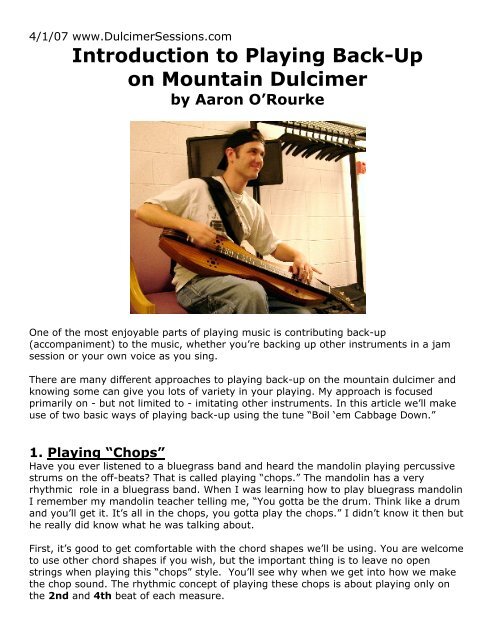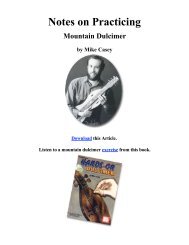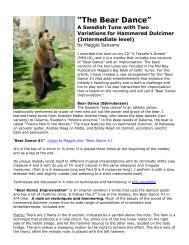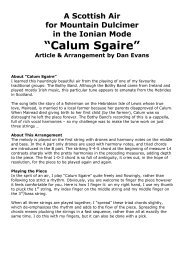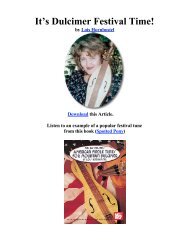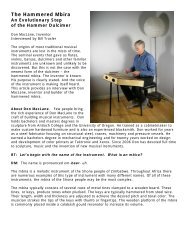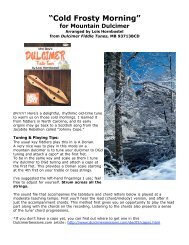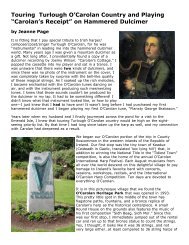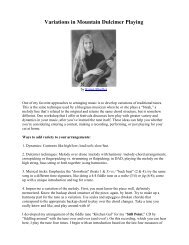Introduction to Playing Back-Up on Mountain Dulcimer
Introduction to Playing Back-Up on Mountain Dulcimer
Introduction to Playing Back-Up on Mountain Dulcimer
You also want an ePaper? Increase the reach of your titles
YUMPU automatically turns print PDFs into web optimized ePapers that Google loves.
4/1/07 www.<strong>Dulcimer</strong>Sessi<strong>on</strong>s.com<br />
<str<strong>on</strong>g>Introducti<strong>on</strong></str<strong>on</strong>g> <str<strong>on</strong>g>to</str<strong>on</strong>g> <str<strong>on</strong>g>Playing</str<strong>on</strong>g> <str<strong>on</strong>g>Back</str<strong>on</strong>g>-<str<strong>on</strong>g>Up</str<strong>on</strong>g><br />
<strong>on</strong> <strong>Mountain</strong> <strong>Dulcimer</strong><br />
by Aar<strong>on</strong> O’Rourke<br />
One of the most enjoyable parts of playing music is c<strong>on</strong>tributing back-up<br />
(accompaniment) <str<strong>on</strong>g>to</str<strong>on</strong>g> the music, whether you’re backing up other instruments in a jam<br />
sessi<strong>on</strong> or your own voice as you sing.<br />
There are many different approaches <str<strong>on</strong>g>to</str<strong>on</strong>g> playing back-up <strong>on</strong> the mountain dulcimer and<br />
knowing some can give you lots of variety in your playing. My approach is focused<br />
primarily <strong>on</strong> - but not limited <str<strong>on</strong>g>to</str<strong>on</strong>g> - imitating other instruments. In this article we’ll make<br />
use of two basic ways of playing back-up using the tune “Boil ‘em Cabbage Down.”<br />
1. <str<strong>on</strong>g>Playing</str<strong>on</strong>g> “Chops”<br />
Have you ever listened <str<strong>on</strong>g>to</str<strong>on</strong>g> a bluegrass band and heard the mandolin playing percussive<br />
strums <strong>on</strong> the off-beats? That is called playing “chops.” The mandolin has a very<br />
rhythmic role in a bluegrass band. When I was learning how <str<strong>on</strong>g>to</str<strong>on</strong>g> play bluegrass mandolin<br />
I remember my mandolin teacher telling me, “You gotta be the drum. Think like a drum<br />
and you’ll get it. It’s all in the chops, you gotta play the chops.” I didn’t know it then but<br />
he really did know what he was talking about.<br />
First, it’s good <str<strong>on</strong>g>to</str<strong>on</strong>g> get comfortable with the chord shapes we’ll be using. You are welcome<br />
<str<strong>on</strong>g>to</str<strong>on</strong>g> use other chord shapes if you wish, but the important thing is <str<strong>on</strong>g>to</str<strong>on</strong>g> leave no open<br />
strings when playing this “chops” style. You’ll see why when we get in<str<strong>on</strong>g>to</str<strong>on</strong>g> how we make<br />
the chop sound. The rhythmic c<strong>on</strong>cept of playing these chops is about playing <strong>on</strong>ly <strong>on</strong><br />
the 2nd and 4th beat of each measure.
Technique Tip:<br />
As so<strong>on</strong> as your pick crosses the strings, relax your fretting hand so you’re not holding<br />
the strings down <str<strong>on</strong>g>to</str<strong>on</strong>g> the fretboard. This will s<str<strong>on</strong>g>to</str<strong>on</strong>g>p the strings from res<strong>on</strong>ating and give you<br />
that chop-like sound. Try a few times just making a chord. I’ve chosen chord positi<strong>on</strong>s<br />
that give me the best “mandolin” sound. However, any other chord you choose that<br />
covers all three (or four) strings will work. Just strum and relax, strum and relax, strum<br />
and relax until your hands start doing it without your having <str<strong>on</strong>g>to</str<strong>on</strong>g> think.<br />
I’ve found that you can really dig in and be heavy handed with this approach <str<strong>on</strong>g>to</str<strong>on</strong>g> back-up<br />
more so than <strong>on</strong> others. Some of these chord shapes can be quite a stretch, so it’s<br />
probably good <str<strong>on</strong>g>to</str<strong>on</strong>g> practice just getting your hand comfortably used <str<strong>on</strong>g>to</str<strong>on</strong>g> these chords for<br />
smooth switching between them. Most importantly, just remember what my old<br />
mandolin teacher <strong>on</strong>ce <str<strong>on</strong>g>to</str<strong>on</strong>g>ld me, “You gotta’ be the drum. Think like a drum and you’ll<br />
get it. It’s all in the chops, you gotta play the chops.”<br />
D G A<br />
Bass: 4 5 4<br />
Middle: 3 3 2<br />
Melody: 2 3 1<br />
Listen <str<strong>on</strong>g>to</str<strong>on</strong>g> Aar<strong>on</strong> “chop” these chords <str<strong>on</strong>g>to</str<strong>on</strong>g> “Boil ‘em Cabbage Down” as Katie Gerringer<br />
plays fiddle.
2. <str<strong>on</strong>g>Playing</str<strong>on</strong>g> the Bass Line – another style of back-up<br />
Imitating a bass player doing back-up is the exact opposite of playing the chops. Now<br />
we’re going <str<strong>on</strong>g>to</str<strong>on</strong>g> play <strong>on</strong>ly <strong>on</strong> the 1st and 3rd beat of each measure and we’re going <str<strong>on</strong>g>to</str<strong>on</strong>g><br />
play <strong>on</strong> the bass string <strong>on</strong>ly. Your fretting hand gets <str<strong>on</strong>g>to</str<strong>on</strong>g> take a well deserved break (after<br />
doing all those stretchy chords for your chops).<br />
The c<strong>on</strong>cept of this style has <str<strong>on</strong>g>to</str<strong>on</strong>g> do with alternating between two notes <strong>on</strong> the bass string<br />
at the first and third beat. These notes are known as the root and the fifth.<br />
Root Fifth<br />
D D (open) A (4th fret)<br />
G G (3rd fret) D (open)<br />
A A (4th fret) E (1st fret)<br />
Listen <str<strong>on</strong>g>to</str<strong>on</strong>g> Aar<strong>on</strong> play “bass-line” back-up <str<strong>on</strong>g>to</str<strong>on</strong>g> “Boil ‘em Cabbage Down” as Katie<br />
Gerringer plays fiddle.<br />
Technique Tip: Try placing the outside edge your hand directly <strong>on</strong> the bridge where the<br />
strings sit. This will dampen the strings a little and give a little more of that thick, “bass<br />
like” <str<strong>on</strong>g>to</str<strong>on</strong>g>ne. The trade-off is that you lose volume. Be careful not <str<strong>on</strong>g>to</str<strong>on</strong>g> dampen the strings<br />
<str<strong>on</strong>g>to</str<strong>on</strong>g>o much or you w<strong>on</strong>’t hear anything. If you feel like you’ve lost <str<strong>on</strong>g>to</str<strong>on</strong>g>o much volume try<br />
rolling your hand back until less and less of your hand is <str<strong>on</strong>g>to</str<strong>on</strong>g>uching the strings.
To c<strong>on</strong>clude this article <strong>on</strong> basic back-up, here’s a sound file of me backing up Katy<br />
Gerringer’s fiddling <strong>on</strong> “Soldier’s Joy”. I’m using the above “chops” and “bass-line”<br />
back-up styles in a kind of free-form way, changing around <str<strong>on</strong>g>to</str<strong>on</strong>g> vary it. I hope you have<br />
lots of fun trying these back-up techniques in your own ways!<br />
About the Author<br />
Aar<strong>on</strong> O’Rourke lives in Tallahassee, Florida. His explorati<strong>on</strong> of the mountain dulcimer<br />
started in high school while playing bass in a punk rock band. He has studied with a<br />
wide range of dulcimer masters and makes up for his brief stay <strong>on</strong> the planet with a<br />
passi<strong>on</strong>ate investment in his playing and teaching. He has w<strong>on</strong> numerous instrumental<br />
competiti<strong>on</strong>s and brings a unique flair <str<strong>on</strong>g>to</str<strong>on</strong>g> his arrangements.<br />
Through his playing Aar<strong>on</strong> effectively combines influences from Irish, bluegrass, Latin,<br />
old-time, and jazz. As a member of “Panhandle String Band and Acoustic <str<strong>on</strong>g>Up</str<strong>on</strong>g>rising,”<br />
Aar<strong>on</strong>’s creative approach <str<strong>on</strong>g>to</str<strong>on</strong>g> the dulcimer as an ensemble instrument focuses <strong>on</strong> backup<br />
as well as blazing-fast leads. In 2005 Aar<strong>on</strong> and some other outstanding young<br />
players recorded “Safe Haven,” a CD benefiting Family Violence Preventi<strong>on</strong>, Inc. He will<br />
be performing and teaching at dulcimer events in the upcoming festival seas<strong>on</strong>, am<strong>on</strong>g<br />
them Western Carolina University <strong>Mountain</strong> <strong>Dulcimer</strong> Week, June 24-29, 2007.<br />
Aar<strong>on</strong> has recorded a CD entitled, “One More Cup of Coffee,” which can be ordered<br />
direct from him at adomed@hotmail.com<br />
He has plans <str<strong>on</strong>g>to</str<strong>on</strong>g> write a book with lots more of his ideas for playing back-up <strong>on</strong> the<br />
mountain dulcimer. For a sample of Aar<strong>on</strong> in performance visit:<br />
http://www.myspace.com/aar<strong>on</strong>orourkedulcimer


